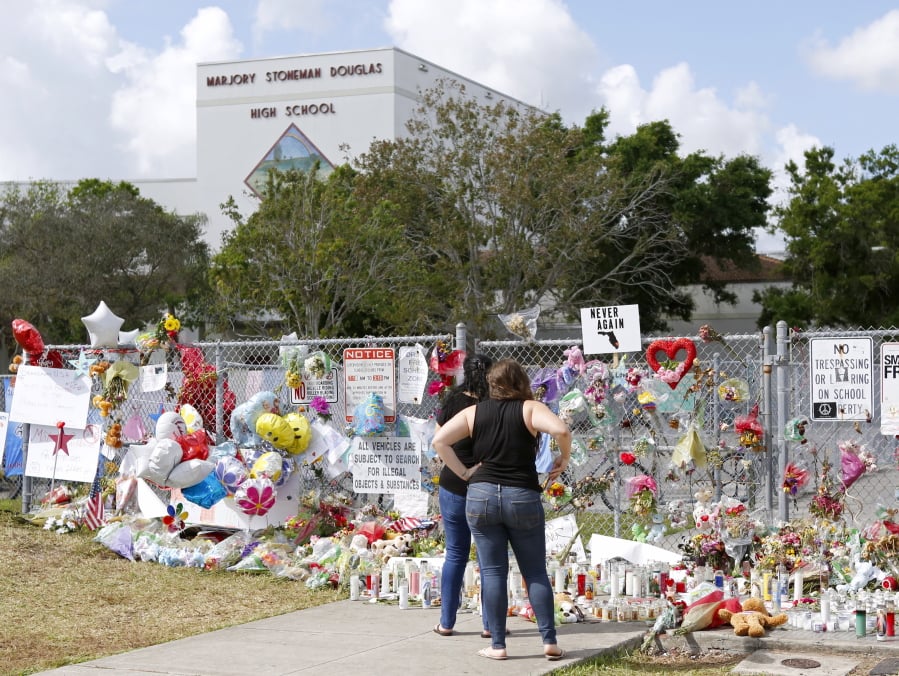Shane Gardner’s worst fear, apart from a school shooting itself, is turning on the TV news and seeing someone he’s worked with say “We never believed it could happen here.”
The reality is, it could.
“That is the enemy of our preparedness, is if we’re complacent,” said Gardner, a former sheriff’s sergeant who is now the safety and security manager at Evergreen Public Schools.
That awareness has brought campus shootings to the forefront of school safety plans. Officials from area school districts say they’re taking a multifaceted approach to preventing and responding to campus violence like last month’s school shooting in Parkland, Fla., which left 17 people dead at Marjory Stoneman Douglas High School. Positive relationships with students, secure facilities, and training on how to respond should a shooter come on campus are key to making sure schools stay safe, officials say.
Some say Clark County is on the cutting edge of campus safety. The county’s approach to school security has been honed over 20 years with the launch of the Clark County Safe Schools Task Force in 1998 after the Thurston High School shooting in Springfield, Ore., said Peggy Sandberg, director of insurance programs for Educational Service District 112 in Vancouver.
“I think we’re ahead of the game,” Sandberg said.
Clark County school administrators meet several times a year to discuss school security, and hold a regional safety summit. Topics change from year to year — including responses to gang violence, drugs on campus and school shootings.
“It’s been in the forefront of the superintendents’ thoughts for years now,” Sandberg said. “They pay for their admins to attend this training every year.”
Run, hide, fight
In the last two decades, schools have changed their campuses to make them more secure. Visitors to Clark County schools, for example, must first enter the campus office and sign in before entering the rest of the building. Other exterior doors are locked during school hours.
Bond-funded construction at Vancouver and Evergreen public schools will continue to add secure entrances to campuses while reducing the number of doors that lead to the outside. Evergreen will also add more security cameras.
Some schools have also implemented the “Run, Hide, Fight” protocol, a program developed by the Department of Homeland Security directing students on how to protect themselves in case of a school shooting.
“We basically give staff and students the ability, the authority to do whatever they’ve got to do to survive,” said Mick Hoffman, executive director of operations, safety and security at Vancouver Public Schools.
Rather than the traditional lockdown, where students lock their classroom door and hunker down while waiting for the danger to pass, some area schools are telling their students to flee campus if it’s safe to do so. If it’s not safe, students and staff are told to find a place to hide, barricading doors if necessary. And if all options are exhausted and someone is cornered by a shooter, fight.
“It’s either that or you drop down and plead for mercy,” Hoffman said. “The person involved usually doesn’t provide that mercy.”
Fostering relationships
District officials say developing relationships between students, teachers and security staff is key in ensuring such crises won’t happen. That means creating a culture at school where students feel safe among their peers and supported by their teachers, said Kym Tyelyn-Carlson, Vancouver Public Schools’ executive director of teaching and learning.
“We’re looking at behavior from the standpoint of something that needs to be taught and nurtured, just like any kind of learning,” Tyelyn-Carlson said.
Sheriff’s Deputy Jason Granneman said school resource officers, such as himself, play a role in that as well. Granneman is assigned as a school resource officer at the Hockinson School District. Usually, he’s breaking up fights on campus or investigating vandalism. For serious cases, Granneman said it’s crucial he have a positive relationship with students and staff so they feel they can speak with a law enforcement agent if they believe there might be a threat to a school.
“We’re not scary,” Granneman said. “We’re friendly and we want them to talk to us.”
Arming teachers
Area teachers and law enforcement have rejected calls by the National Rifle Association and President Donald Trump to arm teachers — an idea Democratic Gov. Jay Inslee criticized at a governors meeting with the president on Monday.
“I am not in favor of armed volunteers patrolling our schools,” Republican Sheriff Chuck Atkins said in a statement to The Columbian. “Only trained staff, employed by and under the direction of the school district, should be used for armed school security.”
Rob Lutz, president of the Evergreen Education Association, called the pitch to harden schools a “cop-out.”
“Instead of trying to deal with a problem, we’re just trying to make our schools locked-down prisons, which is not a solution,” Lutz said.




